Philodendron Xanadu (Thaumatophyllum xanadu) is a unique plant variety that is easy to grow and care for. It has deep green leaves with an intriguing feather-like appearance that adds colour and elegance wherever it grows. Best of all, it thrives indoors and can be easily propagated with stem cuttings.
With a few basic requirements and a touch of love, you'll have a Philodendron Xanadu flourishing in no time, making it a top choice for beginner gardeners. What are these basic requirements? Let's break it down.
About Philodendron Xanadu
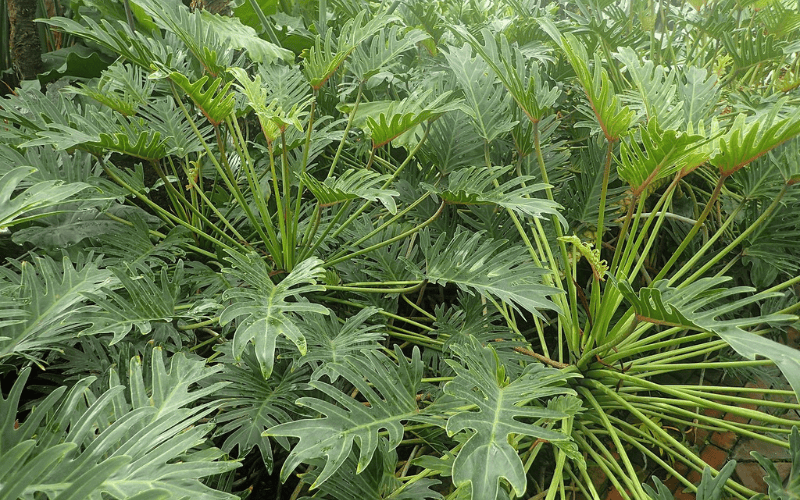
Native to some of the most lush rainforests in Brazil, the Philodendron Xanadu (Thaumatophyllum xanadu) has beautiful foliage and an easygoing personality; it is an ideal plant to grow in homes. It especially thrives in warm and humid templates and has heavily lobed, deep green leaves that give it an exotic appearance.
As established, caring for Philodendron Xanadu is simple and straightforward; it is tolerant towards bright and indirect lighting conditions and requires moderate to avoid dehydration. The general rule of thumb when watering the Xanadu is to let the top layer of the soil dry out in between waterings.
To properly maintain the health and vitality of your Philodendron Xanadu, observe the plant routinely and make any necessary care adjustments where applicable.
Growing Philodendron Xanadu - Critical Factors
To grow the Philodendron Xanadu, remember these key critical growth factors and your plant flourish in your home oasis:
Soil
For a Philodendron Xanadu, loosely packed potting soil that drains well is your best bet. A bit of peat moss is also beneficial, but remember not to overwater. To encourage healthy root growth, we recommend you pick a roomy pot and avoid compacting the potting mix too much to allow the roots to breathe and expand freely.
Light
Xanadu is used to receiving several hours of dappled, indirect light each day as it lives in the understory of a forest. Thus, when grown indoors, it performs best in strong, indirect light. Nevertheless, it can withstand brief periods of low light. Do not subject the plant to prolonged exposure to strong, direct sunshine as it may get leaf burn.
Water
Philodendron Xanadu is a tropical plant that requires consistent moisture to grow well. However, it is important not to overly hydrate this plant, as that can quickly lead to root rot and other issues. The best way to determine when to water your Philodendron Xanadu is by checking the soil moisture level. If it's dry, it's watering time.
As a guide, watering once a week usually does the trick. But bear in mind that the frequency may vary depending on your home's temperature, humidity, and light conditions. You may only need to water your plant more frequently if you live in a dry region or if your house is hot.
Temperature
As a hardy plant, Xanadu can tolerate typical indoor conditions. Having said that, your Xanadu will always benefit from adding more humidity because these tropical plants grow well in humid environments when they are there. Consider putting a small humidifier nearby or relocating your plant to an area that naturally has humidity, like the kitchen, bathroom, or laundry room.
Philodendron Xanadu Propagation (Step-by-Step)
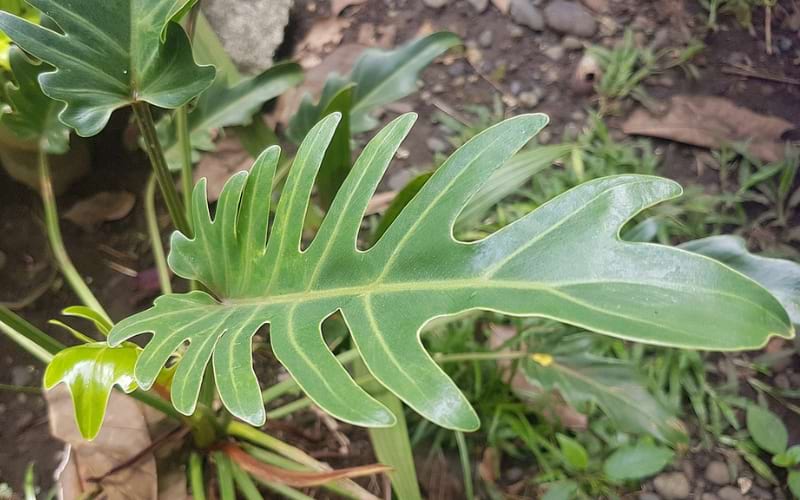
Fancy sharing the tropical charm of the Philodendron Xanadu? Try propagating them through stem cuttings. Here's a quick breakthrough on how to do it.
- Step 1: Choose a healthy and mature Xanadu as the mother plant to extract stems from. Using a sharp pair of shears and aiming for at least three to four nodes, cut a suitable stem.
- Step 2: Remove the lowest leaves from each stem cutting to show the nodes that run the length of the stem. Leaving one to two leaves on each cutting increases the likelihood of success.
- Step 3: Ensure that the surviving leaves are above the water and the nodes are submerged when you place the cuttings in a small container filled with clean water.
- Step 4: Place the container in an area with lots of indirect light, and change the water weekly. You should start to see the development of little white roots after a few weeks. When they are at least an inch long, you can move the cutting from water to soil.
- Step 5: When potting, place the rooted cuttings in a pot with well-draining soil. Be sure the cuttings are well rooted in the soil, then give them a good watering.
- Step 6: You can replant the cuttings close to a window with good light from the pot. Keep the soil evenly moist for the first week to let the roots acclimatise to the new soil.
Tips for Growing Philodendron Xanadu in Pots
Here are some tips to help you successfully grow Philodendron Xanadu in pots:
- Pot selection: Choose a well-draining pot with drainage holes at the bottom. This is important to prevent waterlogging, which can lead to root rot.
- Lighting: Xanadu Philodendron prefers direct light. Placing it in direct sunlight will burn the leaves. The ideal location would have filtered or dappled sunlight.
- Maintain a warm, humid environment for the plant in terms of both temperature and humidity. Xanadu enjoys higher humidity levels and thrives in temperatures between. You can also spray the leaves or set up a humidity tray close by to raise the humidity.
- Watering: Maintain a constant moisture level in the soil that is not flooded. When the top inch of soil seems dry to the touch, water the plant. In order to avoid waterlogging, make sure that any extra water drains from the pot.
- Fertilisation: You can feed the Xanadu Philodendron with a balanced liquid fertiliser every four to six weeks during the growing season (spring and summer).
Philodendron Xanadu Care Guide
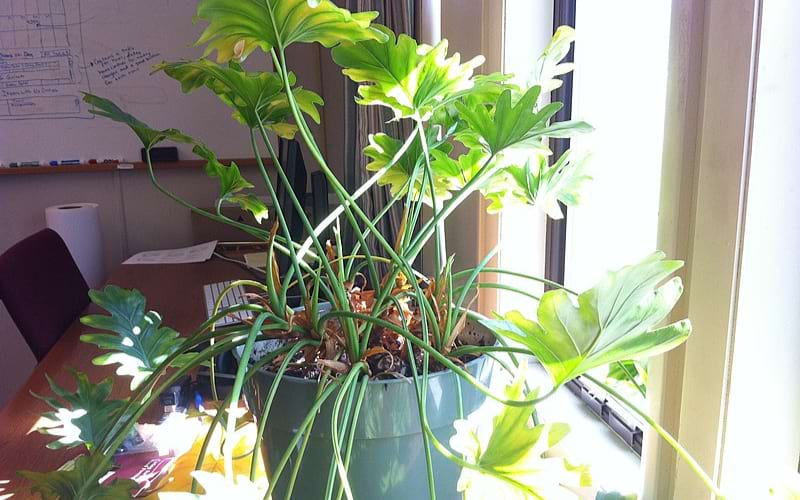
Besides the critical factors necessary for the plant's growth and propagation, here are two similarly essential tips for nurturing this tropical indoor plant.
Fertilising
Fertilising Philodendron xanadu, like many houseplants, is essential to ensure healthy growth and vibrant foliage. Here are some guidelines:
- Use a balanced, water-soluble fertiliser designed for houseplants. Look for a formula with equal NPK ratios or something close to it.
- Fertilise during the growing season, typically spring to early fall, when the plant is actively growing and its nutrient demands are higher. Do not fertilise the plant during the dormant winter months.
- Follow the instructions on the fertiliser packaging for dilution rates. Remember, it's always better to under-fertilise than to over-fertilise, as excessive nutrients can cause harm to the plant.
- Fertilise every four to six weeks during the growing season, depending on the type of fertiliser and the condition of the plant.
- Water the plant lightly before applying the fertiliser to prevent root burn and ensure the nutrients are evenly distributed in the soil.
- When you repot your Philodendron xanadu, we recommend waiting for about 4-6 weeks before applying fertiliser since the fresh potting mix usually contains enough nutrients to sustain the plant during this period.
- Every few months, flush the soil with plain water to remove any accumulated salts from the fertiliser and prevent the buildup of minerals that can harm the roots.
- If you notice leaf browning, wilting, or other signs of nutrient imbalance, it may indicate over-fertilisation. In such cases, stop fertilising immediately and flush the soil.
To keep your Philodendron Xanadu thriving and healthy, give it a balanced liquid fertiliser once a month during spring and summer. But remember, each plant's needs can vary, so pay attention to its response and adjust care as needed.
Pruning
Pruning Philodendron xanadu enhances the plant's health and appearance. To ensure a successful pruning session, it's best to do it during the active growth period, typically in the spring or summer. Begin by inspecting the plant carefully to identify any dead, damaged, or overgrown areas. Use clean and sharp pruning shears to remove dead or yellowing leaves at the base, preventing the spread of diseases. Trimming back leggy growth encourages bushier development, and shaping the plant by cutting back outer stems promotes a balanced and compact appearance.
For more extensive pruning or propagation, consider air layering. After pruning, provide your Philodendron xanadu with appropriate care, placing it in bright, indirect light and maintaining proper watering to aid its recovery. Throughout the growth season, you can prune your Xanadu whenever you see any dead, ill, or damaged leaves. Find an undesired leaf and then follow its stem all the way to the petiole's base after spotting one of these leaves. Removing dead stems will improve the plant's light and ventilation, which will aid in its growth.
Repotting and Potting the Philodendron Xanadu
Once the Philodendron Xanadu starts to outgrow its current pot is when it needs to be repotted. This typically implies once every one to two years, depending on the health and growing conditions of your plant.
Select a replacement pot that is two to three inches bigger than the old one. To reduce the chance of shock, you should ideally wait to repot your plant until late winter or early spring. After that, thoroughly water the newly repotted plant and refill as much soil as you can with fresh soil mix.
Common Problems to Look Out For
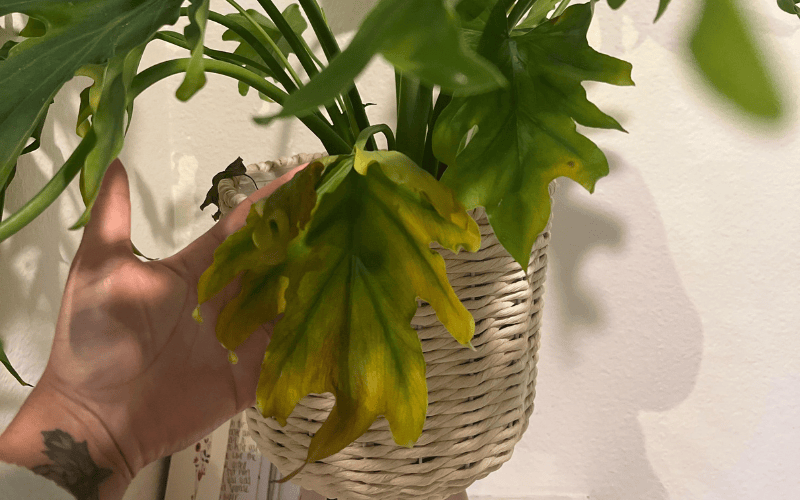
While the Xanadu is generally low-maintenance, you can come across some issues that will most certainly turn major if you don't act fast. Let’s take a look at what they are:
Brown Leaves
The philodendron xanadu is one of many indoor plants that frequently have brown leaves. They may indicate underwatering, a lack of light, an excessive amount of light, or a lack of humidity. Again, the only method to identify the problem and stop the browning of your plant's leaves is to carefully examine the conditions in which your plant grows and see for yourself what you think is affecting the plant.
Yellow Leaves
Yellowing leaves may indicate a problem with how you are taking care of your plant. It's usually nothing to worry about if your plant grows one or two yellow leaves as it ages, especially if they are older leaves. However, you certainly have a bigger issue on your hands if all of your plant's leaves start turning yellow and dropping off at once.
Yellow leaves can be a clear indication that your plant is getting too little or too much light. It can also be due to issues of over or underwatering. Since this is a bit difficult to conclude, you will again need to check your plant's specific environment to see which of the problems from above could be your root cause and begin a solution from there.
Root Rot
Root rot is a clear indication of excess moisture in your plants. A lack of drainage holes in your pot or an overly cool environment could accentuate this problem and lead to retained moisture. Try placing your Xanadu plant in a brighter spot or add drainage holes that can help absorb moisture. If you see signs of root rot in its early stage, prune affected leaves and roots and replant them. But, if the rot has spread out of control, you may need a new plant.
Pests
If its growing environment is not favourable, the Xanadu may experience spider mite problems similar to other philodendrons. Check your philodendron's leaves frequently to make sure there are no infestations because it may also draw aphids or mealy bugs.
Pests on your philodendron can be physically eliminated using a moist cloth or by misting the plant with water. Trim off all impacted leaves before gently washing your plant with an insecticide soap.
Toxicity of Philodendron Xanadu
Much like other plants in the Philodendron genus, the Xanadu contains calcium oxalate crystals which can be toxic to humans and pets upon ingestion. The symptoms include:
- Oral irritation: Mouth, tongue, and throat swelling, redness, and a burning feeling.
- Swallowing difficulties: Due to the crystals' irritant effects, swallowing may become painful.
- Feeling sick: Vomiting and nausea are side effects of ingestion that can cause gastrointestinal distress.
- Drooling excessively: Mouth irritation can result in more salivation.
- Pawing at mouth: Pets may claw at their mouths in an effort to relieve the discomfort.
More significant symptoms, such as breathing problems and airway edoema, can manifest in extreme cases or after massive ingestions. Seek immediate medical or veterinary care if you believe anyone, including pets, may have consumed Philodendron Xanadu.
Philodendron Xanadu Uses Cases
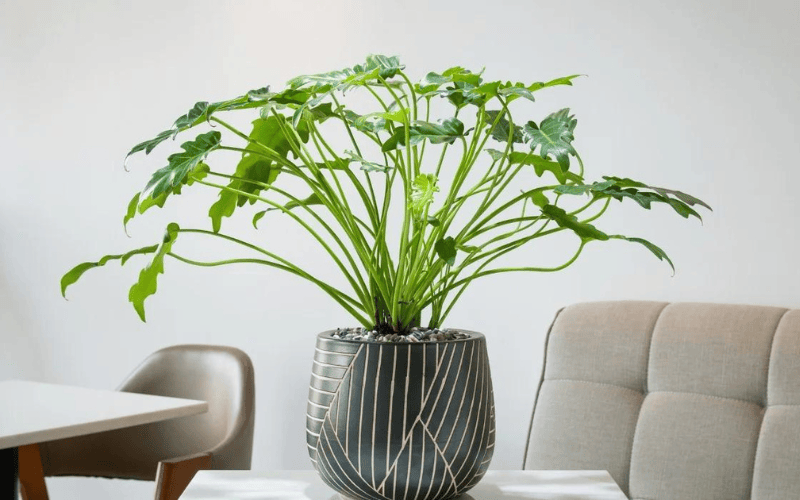
Philodendron Xanadu has several uses and applications, both indoors and outdoors. Here are some common use cases for this tropical plant:
- Ornamental Houseplant: One of the primary uses of Philodendron Xanadu is as an ornamental houseplant. Its lush, tropical appearance with glossy, deeply lobed leaves makes it a popular choice for indoor spaces. It adds a greenery touch and a tropical ambiance to homes, offices, and other indoor environments.
- Indoor Landscaping: Philodendron Xanadu is often used in indoor landscaping projects, such as in malls, hotels, and other public spaces. Its attractive foliage and low-maintenance nature make it suitable for creating green and inviting indoor landscapes.
- Patio and Balcony Planting: In mild climates, Philodendron Xanadu can be used as a container plant on patios and balconies, adding a tropical touch to outdoor living spaces.
- Shaded Gardens: In suitable outdoor conditions, Philodendron Xanadu can be grown in shaded or partially shaded gardens as a ground cover or underplanting beneath taller trees and shrubs. It can help fill in spaces with its dense, bushy growth habit.
- Landscaping in Tropical Climates: In tropical and subtropical regions, Philodendron Xanadu is often used for its lush appearance and adaptability to shade.
- Indoor Air Purification: Like many houseplants, Philodendron Xanadu can help improve indoor air quality by filtering out certain pollutants and toxins from the air.
- Foliage for Floral Arrangements: The attractive foliage of Philodendron Xanadu can be used in floral arrangements and cut flower displays, adding texture and greenery to the composition.
- Low-Maintenance Plant: Philodendron Xanadu is favored by many for its ease of care. It requires minimal attention and can tolerate various indoor conditions, making it an excellent choice for those new to houseplant care.
Are you planning a garden redesign or in need of some landscaping advice? Our guide on how to find the best landscaper in Australia is a great resource. These professionals provide everything from design inspiration to full-service landscaping, helping you transform your outdoor space into a beautiful garden masterpiece.
🪴Need Assistance With Gardening?
Whether you're a seasoned green thumb or just starting out in gardening, there's always more to learn. Immerse yourself in our guide to finding the perfect gardener in Australia. These top-rated professionals offer a variety of services, from plant selection to garden maintenance, ensuring your garden remains vibrant and healthy.
🌲Seeking Help With Lawn Care?
Maintaining a beautiful lawn can be a significant undertaking. If you're in need of expert assistance, look no further than our carefully curated guide on choosing the right lawn mowing service in Australia. These experts can help keep your outdoor spaces at their greenest and cleanest best with their lawn mowing and care expertise.
Frequently Asked Questions (FAQs)
Here are some frequently asked questions about the Philodendron Xanadu.
How fast will Philodendron Xanadu plants grow?
On average, you can expect Philodendron Xanadu to grow several inches per year under ideal conditions. The growth rate of Philodendron Xanadu plants depends on several factors, such as environmental conditions, care, and age of the plant. Typically, younger Philodendron Xanadu plants exhibit faster growth compared to mature ones. Growth rates are also slower in indoor settings compared to their natural habitat.
Is Philodendron Xanadu easy to grow?
Yes, Philodendron Xanadu is generally considered an easy plant to grow. Its resilience and adaptability make it a popular choice for both beginners and experienced plant enthusiasts. The plant's tropical nature allows it to thrive in various conditions, making it relatively low-maintenance compared to some other houseplants.
Where do Philodendron Xanadu plants grow best?
Philodendron Xanadu plants thrive best in bright, indirect light. They prefer locations with filtered sunlight or partial shade. Avoid placing them in direct sunlight, as it can scorch their leaves. Indoors, they do well near a north or east-facing window, where they receive gentle, indirect light. Outdoors, they can be grown under the shade of taller trees or in areas with dappled sunlight.
• Philodendron Silver Sword: A striking philodendron variety with long, sword-shaped leaves showcasing a shimmering silver-green hue, adding an elegant touch to any indoor space.
• Philodendron White Princess: A captivating philodendron cultivar featuring heart-shaped leaves adorned with beautiful white variegation, creating a stunning contrast against the deep green backdrop.
• Philodendron Prince of Orange: A vibrant philodendron hybrid that boasts brilliant orange leaves when young, transitioning to a lustrous green as they mature, bringing a pop of warm color to any plant collection.
Embracing the Tropical Charm: Your Philodendron Xanadu Journey
Armed with these practical tips, your journey with Philodendron Xanadu is poised to be a joyful one. Whether you're sprucing up an existing companion or inviting a new one into your home, these guidelines will keep you on track. Remember always to steal some quiet moments with your green friend, checking in for signs of browning leaves or those pesky pests.
And most importantly, afford your plant the freedom to grow, unfurl and reach for the light at its own pace. In the garden of life, patience is indeed a virtue, a virtue that rewards you with a thriving, verdant companion. Here's to many delightful moments of green-thumbed joy!







